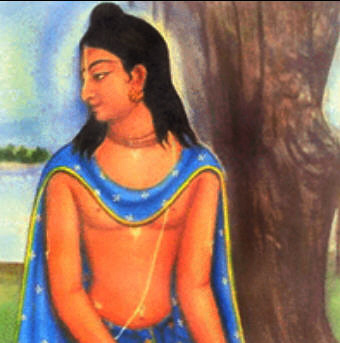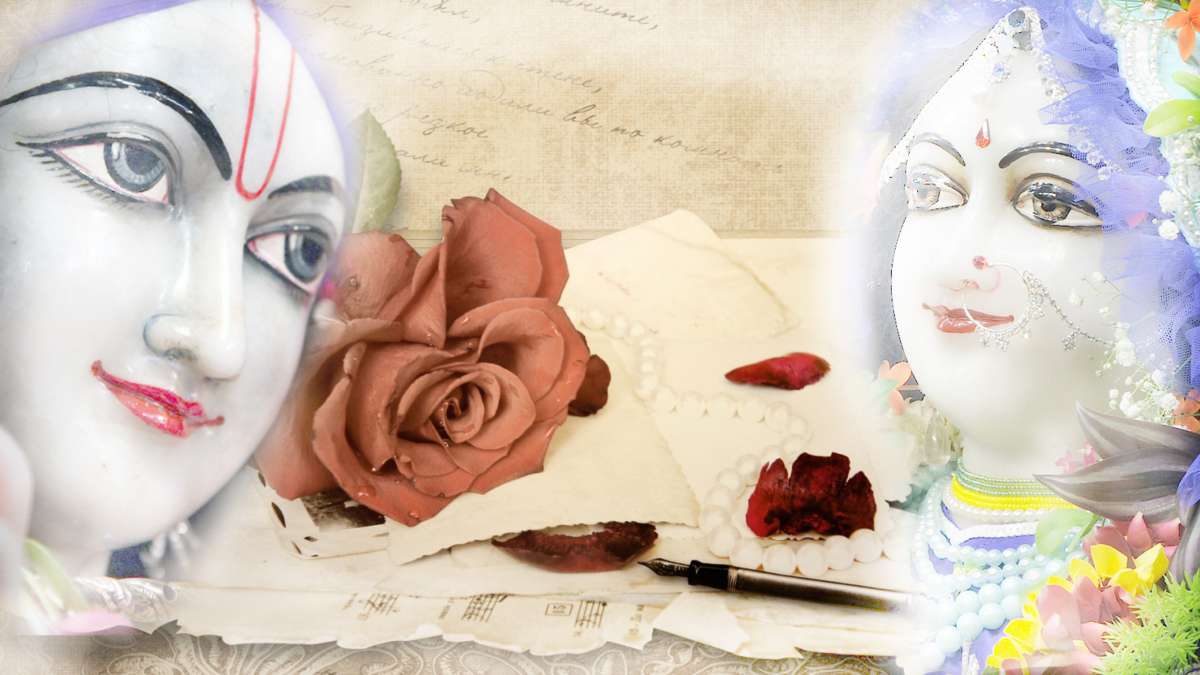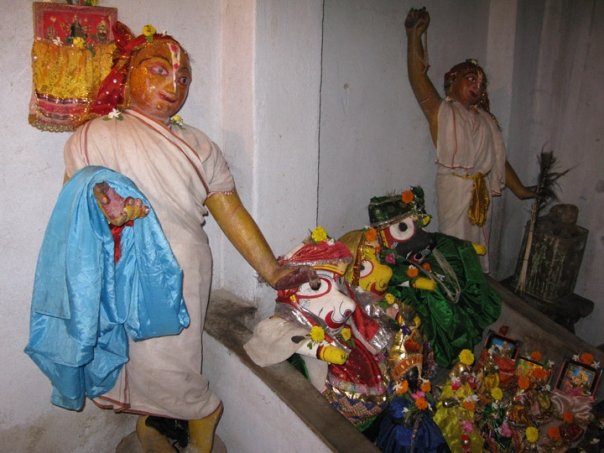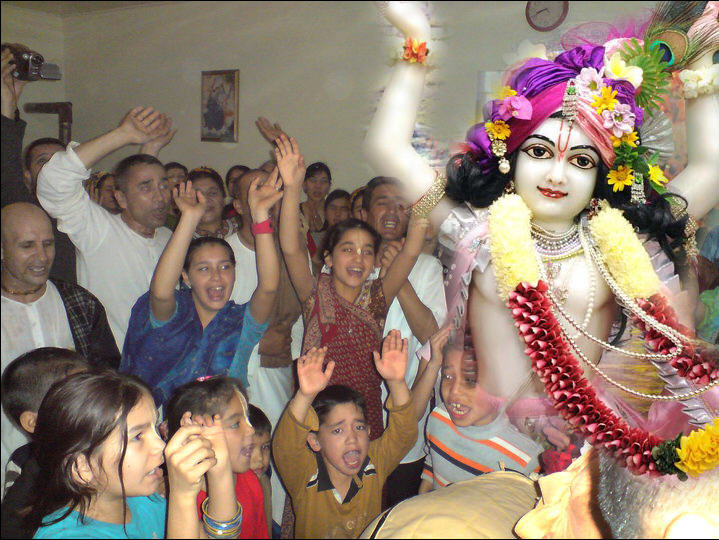
Shrila Narahari Sarkar Thakur is counted as one of Chaitanya’s branches on the desire tree of pure devotional service. By Mahaprabhu’s desire, he took birth in a physician (vaidya) family, blessing his family by so doing. He was the Lord’s chief associate amongst the residents of the village of Shrikhanda. (In the image: Shrila Narahari Sarakara Thakura).
adhuna narahary-akhyah sarakarah prabhoh priyah
She who was previously Radha’s intimate girlfriend named Madhumati is today Narahari Sarkar, the Lord’s dear associate. (Gaura-ganoddesha-dipika 117)
Shrila Narahari Sarkar Thakur is counted as one of Chaitanya’s branches on the desire tree of pure devotional service. By Mahaprabhu’s desire, he took birth in a physician (vaidya) family, blessing his family by so doing. He was the Lord’s chief associate amongst the residents of the village of Shrikhanda. The Shrikhanda railway station is in Burdwan district four miles west of Katwa. Narahari’s home is about one mile from the station.
Some of the other residents of Shrikhanda who were Devotees of Lord Chaitanya were: Shri Mukunda, Shri Raghunandan, Shri Chiranjiva, Shri Sulochana, Shri Damodar Kaviraj, Shri Ramachandra Kaviraj, Shri Govinda Kaviraj, Shri Balaram Das, Shri Ratikanta, Shri Ramagopala Das, Shri Pitambara Das, Shri Sachinandana, Shri Jagadananda, etc. Krishnadas Kaviraj Goswami mentions many of these names as Chaitanya’s branches that generously distributed the fruits of love of God. (Chaitanya Charitamrita 1.10.78-9)
The scholar Bharat Mallik has written the following Sanskrit verses about Narahari’s appearance in a vaidya family in his book Chandra-prabha:
shrikhanda-nama-nagari radhe bangeshu vishruta
sarvesham eva vaidyanam ashrayo yatra vidyate
yatra goshthi-bhuta vaidya yah khando’bhud bhishak-priyah
visheshatah kulinanam sarvesham eva vasa-bhuh
In Bengal, in the area known as Rarha (Burdwan, Birbhum), there is a famous town known as Shrikhanda that gave shelter to all the physician clans. Since vaidyas gathered there, it became a favored residence for them, especially those who were of the most noble birth.
In the Gaudiya Vaishnava Abhidhana, it is stated that Narahari Sarkar Thakur appeared in either the Shaka year 1401 or 1402 (1479-80 AD). His father’s name was Shri Narayan Das, his mother Shri Goyi. Shri Goyi was the daughter of Murari Sena. Narayan Das had three sons, Mukunda, Madhava and Narahari. Raghunandan Thakur was Mukunda’s son. (Bhakti-ratnakara 11.730-1).
The author of Chaitanya Mangala, Lochana Das, who came from the village of Kogram, near Jhamatpur, was Narahari’s disciple. For this reason, Lochana Das writes that Shrila Gadadhara Pandit Goswami and Narahari Sarkar Thakur were Mahaprabhu’s dearest associates. On the other hand, in Chaitanya Bhagavat, Vrindavan Das Thakur has not spoken at any length about the Devotees of Shrikhanda.
Shrila Lochana Das Thakur has written the following about his guru in Chaitanya Mangala:
Narahari Das Thakur is my worshipable master. He possessed the power of the pure lineage of a family of physicians. His body was permeated by love for Krishna, and other than Krishna-prema, he taught nothing to those who were his disciples. He was previously known as Madhumati, one of Radha’s dearest sakhis in Vrindavan, a storehouse of sweetness. Now in the Age of Kali, with the appearance of Gauranga, he has become the keeper of the storehouse of love for Radha and Krishna.

Even before becoming Mahaprabhu’s associate, he composed songs glorifying Radha and Govinda’s pastimes. When Shrila Gadadhara Pandit Goswami was constantly by the Lord’s side, engaged in His service, Narahari had the good fortune to enter into His association. (In the wallpaper: Shri Shri Radha Gopinath, ISKCON Chowpatty, Mumbai).
After the death of his father Narayan, Narahari’s older brother Mukunda arranged for him to study in Navadwip. It is said that Mukunda sometimes worked as the Shah’s family physician. Narahari quickly became very learned as well as a connoisseur of the flavors of devotional. Even before becoming Mahaprabhu’s associate, he composed songs glorifying Radha and Govinda’s pastimes. When Shrila Gadadhara Pandit Goswami was constantly by the Lord’s side, engaged in His service, Narahari had the good fortune to enter into His association. Narahari Sarkar Thakur’s personal service was to fan the Lord with the yaktail whisk. Shrila Bhaktivinoda Thakur, Mahaprabhu’s personal representative, confirmed this in his Gaura-arati:
narahari adi kare camara dhulay
saïjaya, mukunda, vasu ghosha adi gay
Narahari and the other residents of Shrikhanda fanned with the camara, while Sanjaya, Mukunda and Vasu Ghosh sang.
Narahari wrote several books, including Bhakti-chandrika-patala, Shri-Krishna-bhajanamrita, Shri-chaitanya-sahasranama, Shri-Sachinandanashtaka, Shri-Radhashtaka, etc. All of these are well known and thought of highly by the Devotees.

Shri Shri Gaura Gadadhara Deities of Sarakara Thakura, Vishakha Math, Puri).
The following story is told about Narahari: Once when Mahaprabhu and Nityananda Prabhu came to his house in Shrikhanda, they suddenly expressed a desire for honey. Narahari demonstrated his miraculous powers by transforming the water in a pond near his house into honey. He quenched the Lords’ desire for honey with water from this pond, which has ever since been called Madhu-pushkarini. The Lord gave Narahari the order in a dream to install three Deities of Himself, which are currently worshipped in Shrikhanda, Katwa and Ganganagara.
Narahari Sarakar Thakur also participated in the Lord’s activities in Puri. He and the other residents of Shrikhanda would come every year with Shivananda Sena (Chaitanya Charitamrita 2.1.132). After His pilgrimage to South India, when He had saved so many people by giving them love for Krishna, Mahaprabhu returned to Puri when Nityananda sent his servant Kala Krishna Das back to Bengal to tell everyone of the Lord’s arrival. All the Devotees immediately made arrangements to go to Jagannath Puri to see the Lord. The Khanda-vasis were amongst their number.
Mukunda, Narahari, and Raghunandan from Shrikhanda arrived at Advaita Acharya’s house to go to Nilachala. (Chaitanya Charitamrita 2.10.90)
After Jagannath’s Snana Yatra, Jagannath would be unavailable for darshan. Mahaprabhu would go to Alalanath during this time in search of relief from the feelings of separation do to not being able to see Jagannath. When Sarvabhauma Bhattacharya asked Gopinath Acharya to identify the Lord’s Devotees, he mentioned the names of Narahari, Mukunda Das, Raghunandan, Chiranjiva and Sulochan. (Chaitanya Charitamrita 2.11.92)
During the Rathayatra festival, the Lord formed seven kirtan groups with the Devotees from Bengal. One of these was composed uniquely of the Devotees from Shrikhanda. Krishnadas Kaviraj Goswami writes that Narahari and Raghunandan were the dancers for this group, which sang separately from the others. (Chaitanya Charitamrita 2.13.46)
When the Lord gave all the Devotees directions for service, He told Narahari to remain in the association of Devotees. (Chaitanya Charitamrita 2.15.132)
Many people confuse the author of Bhakti-ratnakara, Narahari Chakravarti, with Narahari Sarakar Thakur. The former, who is also known as Ghanashyama Das, is a different person who was born in the district of Murshidabad. His father’s name was Jagannath Chakravarti and he was a disciple of Vishvanath Chakravarti. On Govindaji’s order, he was engaged as the cook for the Govinda Temple and was known as the “cooking pujari” (rasuiya pujari) in Braj.
The following song was written by Narahari Sarakar Thakur:
aola gaura puna hi nadiya pura
hoyata manahi ullasa
aiche ananda kanda kiye heraba
karabahi kirtana vilasa
hari hari,
kaba hama heraba so mukha-cada
viraha payodhi kabahu dina pan raba
tutaba hridayaka bandha
kundana kanaka panti keba heraba
yajïa ki sutra viraja
bahu-jugala tuli hari hari bolaba
natana bhakata-gana majha
eta kahi nayana mudi bahu saba jana
gaura prema bhela bhora
narahari dasa asha kaba puraba
heraba gaura-kishora
If Gaura came back to Nadia town, my mind would be filled with joy. Then I would see Him, the source of all joy, performing His kirtan pastimes.
Hari Hari! When will I again gaze upon that moon-like face? When will that day come when the dam holding the ocean of separation in my heart breaks?
When will I see the golden form of the Lord, wrapped in His yajna-sutra? Lifting my arms in the air, I will shout “Hari! Hari!” and dance in the midst of the Devotees.
Saying such things, many of Gaura’s Devotees close their eyes and merge into love for Him. When will Narahari’s desires be filled? When will he gaze again upon the form of the young Gaura?
Narahari disappeared in around 1540 AÒ. [Not according to his descendants, who say that he lived 100 years until 1578 or so.] in the month of Agrahayan on the Krishna Ekadashi day. Shrinivas Acharya officiated at his funeral ceremony. Nityananda Prabhu’s son Virachandra Goswami and many other important Vaishnavas were in Shrikhanda to celebrate Narahari’s disappearance feast, which is described in Bhakti-ratnakara:
Some people said, “Brothers! Do not leave right away. An ocean of prema will flood over in Shrikhanda in a few days. On the thirteenth day of the waning moon of Agrahayan, when Narahari Thakur disappeared, a great festival will be held here.” (Bhakti-ratnakara 9.512-4)
[Excerpted from “Shri Chaitanya: His Life & Associates” by Shrila Bhakti Ballabh Tirtha Maharaj]

If Gaura came back to Nadia town, my mind would be filled with joy. Then I would see Him, the source of all joy, performing His kirtan pastimes. Hari Hari! When will I again gaze upon that moon-like face? When will that day come when the dam holding the ocean of separation in my heart breaks? When will I see the golden form of the Lord, wrapped in His yajna-sutra? Lifting my arms in the air, I will shout “Hari! Hari!” and dance in the midst of the Devotees. (In the wallpaper: Harinaam Sankirtan, ISKCON Ashgabat, Turkmenistan, Shri Gaurachandra, ISKCON Chowpatty, Mumbai).



